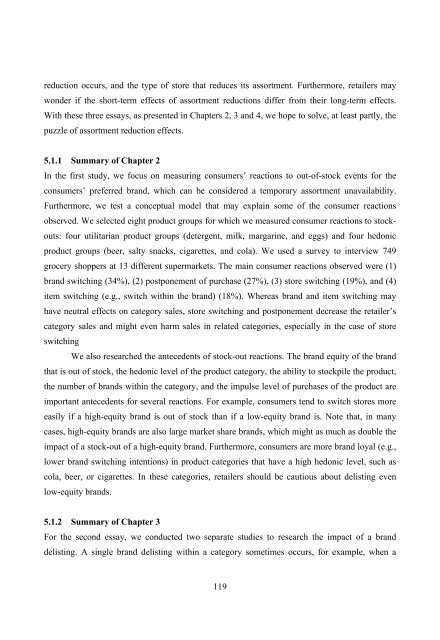Understanding Consumer Reactions to Assortment Unavailability
Understanding Consumer Reactions to Assortment Unavailability
Understanding Consumer Reactions to Assortment Unavailability
You also want an ePaper? Increase the reach of your titles
YUMPU automatically turns print PDFs into web optimized ePapers that Google loves.
eduction occurs, and the type of s<strong>to</strong>re that reduces its assortment. Furthermore, retailers may<br />
wonder if the short-term effects of assortment reductions differ from their long-term effects.<br />
With these three essays, as presented in Chapters 2, 3 and 4, we hope <strong>to</strong> solve, at least partly, the<br />
puzzle of assortment reduction effects.<br />
5.1.1 Summary of Chapter 2<br />
In the first study, we focus on measuring consumers’ reactions <strong>to</strong> out-of-s<strong>to</strong>ck events for the<br />
consumers’ preferred brand, which can be considered a temporary assortment unavailability.<br />
Furthermore, we test a conceptual model that may explain some of the consumer reactions<br />
observed. We selected eight product groups for which we measured consumer reactions <strong>to</strong> s<strong>to</strong>ck-<br />
outs: four utilitarian product groups (detergent, milk, margarine, and eggs) and four hedonic<br />
product groups (beer, salty snacks, cigarettes, and cola). We used a survey <strong>to</strong> interview 749<br />
grocery shoppers at 13 different supermarkets. The main consumer reactions observed were (1)<br />
brand switching (34%), (2) postponement of purchase (27%), (3) s<strong>to</strong>re switching (19%), and (4)<br />
item switching (e.g., switch within the brand) (18%). Whereas brand and item switching may<br />
have neutral effects on category sales, s<strong>to</strong>re switching and postponement decrease the retailer’s<br />
category sales and might even harm sales in related categories, especially in the case of s<strong>to</strong>re<br />
switching<br />
We also researched the antecedents of s<strong>to</strong>ck-out reactions. The brand equity of the brand<br />
that is out of s<strong>to</strong>ck, the hedonic level of the product category, the ability <strong>to</strong> s<strong>to</strong>ckpile the product,<br />
the number of brands within the category, and the impulse level of purchases of the product are<br />
important antecedents for several reactions. For example, consumers tend <strong>to</strong> switch s<strong>to</strong>res more<br />
easily if a high-equity brand is out of s<strong>to</strong>ck than if a low-equity brand is. Note that, in many<br />
cases, high-equity brands are also large market share brands, which might as much as double the<br />
impact of a s<strong>to</strong>ck-out of a high-equity brand. Furthermore, consumers are more brand loyal (e.g.,<br />
lower brand switching intentions) in product categories that have a high hedonic level, such as<br />
cola, beer, or cigarettes. In these categories, retailers should be cautious about delisting even<br />
low-equity brands.<br />
5.1.2 Summary of Chapter 3<br />
For the second essay, we conducted two separate studies <strong>to</strong> research the impact of a brand<br />
delisting. A single brand delisting within a category sometimes occurs, for example, when a<br />
119

















